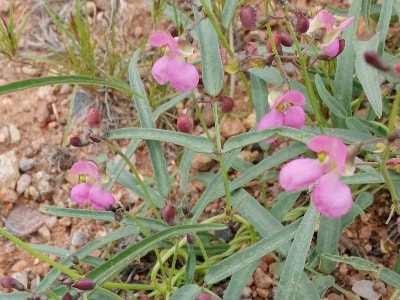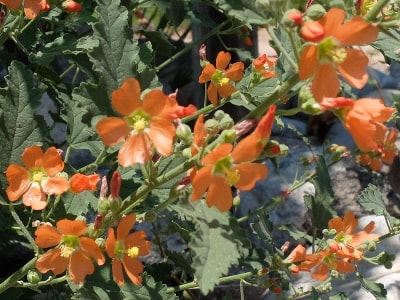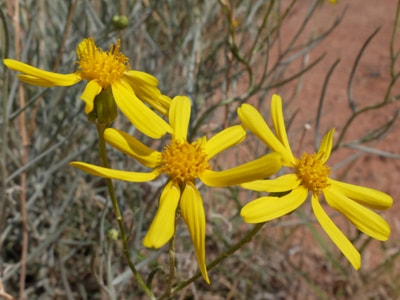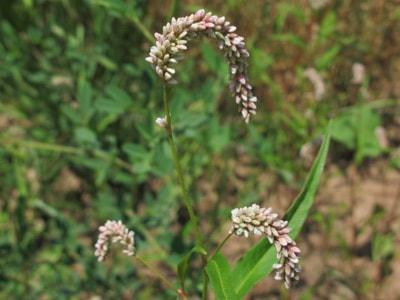|
Found on dry hillsides
Seen blooming on August 27, 2018 in Red Wash Canyon Slimleaf Bean is a long twining and trailing plant with leaves divided into three narrow leaflets. Pink, pea-like flowers grow from the leaf axils. Flowers are less than ½ inch long and have five petals, one of which is tightly coiled. Narrow seed pods are up to 3" long. I was surprised to learn that this slender little plant with delicate flowers was used to strengthen a child. This is from the Annual Report of the Bureau of American Ethnology to the Secretary of the Smithsonian Institution published in 1915: “When an infant boy evinces timidity his father carries a small quantity of corn meal wrapped in a bit of corn husk to the warrior of his choice, and, presenting it, requests that the warrior apply the medicine to his child that he may have a brave heart and never be afraid of the enemy. Crushed leaves and blossoms with the powdered root of this plant are chewed by the officiating warrior and ejected into his hands, which he rubs over the nude body of the child; he also gives the child a small quantity of the crushed blossoms to eat. This is sure to give the boy a brave heart, and he manifests a desire to fight on the slightest provocation.” Source. If you want to identify a different flower then you might find it useful to check what was blooming this time last year. If you cannot identify a flower from the website send a photo and where you took it to [email protected]. Read online for tips.
0 Comments
Found in dry areas, woodlands, roadsides
Seen blooming on August 19, 2018 by Hwy 554 Several species of Globemallow grow in this area blooming from spring until fall. They have five orange petals forming a saucer-like flower. The foliage is covered with star-shaped hairs giving it a grey-green appearance. The shape of the leaves differentiate the species. Blooming now is Fendler’s Globemallow which grows to 4 feet tall with graceful stems; it can become shrub-like. Leaves are divided into three lobes, two smaller side lobes and a larger central lobe, all with scalloped edges. Flowers are over 1 inch across and produce a disc-shaped fruit with 11 to 15 segments, each segment contains a seed. Globemallow has been used to treat sand cricket bites; an infusion of the plant was taken for mouth sores and for internal injury and hemorrhage and it was also made into a lotion to treat external injuries. Source. If you want to identify a different flower then you might find it useful to check what was blooming this time last year. If you cannot identify a flower from the website send a photo and where you took it to [email protected]. Read online for tips. Threadleaf Ragwort, Threadleaf Groundsel, Cenicillo,Senecio flaccidus,Sunflower family (Asteraceae)8/17/2018 Found in dry rocky, sandy areas, washes
Seen blooming on August 13, 2018 in Red Wash Canyon The Senecio genus is a large group which grows in a variety of habitats and life zones. Their common name, Ragworts, also called Butterweeds and Groundsels, have yellow, daisy-like flowers, usually in clusters, with only a few petals. Threadleaf Ragwort typically grows two feet wide and high, but can be taller, with multiple stems. The stems are bluish-green and it has narrow, deeply divided leaves. Both stems and leaves are covered in fine white hairs. It blooms in the spring and again after monsoon rains. It is known to contain alkaloids which can cause liver damage in livestock if consumed in large quantities but it has a variety of medicinal uses. It is a strong laxative and was used internally to treat stomach and kidney trouble; it was used externally as an infusion or salve to treat infected sores and cuts, sore muscles, acne, and skin diseases; the plant was used as a broom, and the herbage was added to bedding as a bug repellent. Source. If you want to identify a different flower then you might find it useful to check what was blooming this time last year. If you cannot identify a flower from the website send a photo and where you took it to [email protected]. Read online for tips. Found in moist or wet soils near streams and lakes
Seen blooming on August 3, 2018 by Abiquiu Lake Grows from 4 to 30 inches tall with thick, erect, reddish stems and narrow lance-shaped leaves, sometimes with a dark blotch in the middle of the leaf which gives it one of its many common names, Lady’s Thumb. The tiny pale pink to greenish-white flowers grow in a dense nodding spike up to 3 inches long. The whole plant is antiseptic and astringent. An infusion has been used in the treatment of stomach complaints and fevers. The plant produces a soft white mass, a froth like that of soap. It is applied externally to burns and is used for bathing, and washing clothes. Source. If you want to identify a different flower then you might find it useful to check what was blooming this time last year. If you cannot identify a flower from the website send a photo and where you took it to [email protected]. Read online for tips Found in disturbed soil, lawns, fields, orchards
Seen blooming on July 29, 2018 in my yard Although this plant can be weedy or invasive, it has attractive, funnel-shaped flowers which are white to pink and 1 inch across. The flowers close at night and during rainy weather. It is a vine that climbs and creeps across the ground with arrow-shaped leaves. It intertwines and topples native species competing for sunlight, moisture and nutrients and is considered noxious in 22 US States. Despite this, it has multiple health benefits and medicinal uses. Native Americans would use the plant as an antidote to spider bites, and the leaves of the plant were believed to enhance the secretion of bile. A tea made from the flowers is laxative and is also used in the treatment of fevers and wounds. An extract of bindweed is believed to arrest the growth of tumors, and its anticancer properties are presently being researched. Read more. If you want to identify a different flower then you might find it useful to check what was blooming this time last year. If you cannot identify a flower from the website send a photo and where you took it to [email protected]. Read online for tips. |
AuthorI am Marilyn Phillips, a native of England, whose love of nature and the outdoors from childhood brought me by a circuitous route to Crested Butte, Colorado in 1993 and 16 years later to northern New Mexico. My exploration of the many trails in these areas, my interest in wildflowers and photography, and career in computer system design came together in this creation. If you have any corrections, comments or questions, please contact me by email. Archives
September 2025
Categoriescopyright © 2020
|







 RSS Feed
RSS Feed